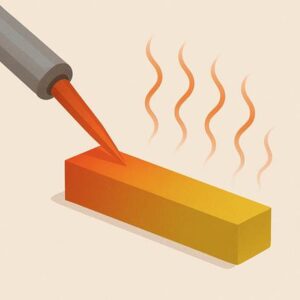Have you ever wondered why the soldering iron tip or reflow oven needs to get so much hotter than the melting point of the solder alloy itself? If SAC305 fully melts at around 220°C, why are we setting reflow peak temperatures 20 degrees higher? Why is the soldering iron tip cranked up to 350°C?

At first glance, it might seem excessive. But once you understand the thermodynamics behind soldering, it makes perfect sense. It all comes down to how heat moves, and how much of it is lost before it gets where it needs to go.
The Role of Energy Conservation
When a heat source touches a surface, everything doesn’t instantly reach the same temperature. Raising an object’s temperature takes time and energy. Heat must flow into the object until it accumulates enough to cause a change.
Think of the heat source like a faucet pouring thermal energy instead of water. Turning it on doesn’t instantly fill a bucket. How fast the bucket fills depends on the flow rate, the size of the bucket, and how much it can hold. Now imagine that bucket leaks—some of the water constantly escapes into the surroundings.
That’s essentially what happens during soldering. Heat doesn’t appear or vanish, it simply redistributes throughout the system. According to the law of conservation of energy, every bit of heat we apply is distributed somewhere within the system. The solder, components, PCB, and surrounding air all absorb and share that energy at different rates.
This is why we don’t just heat to the melting point, we overshoot it. It’s like trying to fill a leaky bucket: a slow stream might never get it full, but a faster flow can overcome the loss. The extra degrees serve the same purpose. They compensate for heat lost to the environment and materials. And the larger or more conductive the materials are, the more heat they draw away from the joint, leaving less for the solder itself.
What Newton Has to Do with Soldering
Newton’s Law of Cooling tells us that the rate at which an object changes temperature is proportional to the difference between its temperature and the temperature of its surroundings. In simpler terms: the bigger the temperature difference, the faster heat transfers.
In the context of soldering, that “object” we’re trying to heat is the solder alloy, and maybe more importantly, the surface it’s meant to wet to, like a PCB pad or component lead. These surfaces are typically at room temperature or slightly elevated, while your soldering iron tip or reflow air is much hotter. The larger that temperature gap, the faster and more effectively heat flows into the joint.
So, we deliberately overshoot the melting point to guarantee enough thermal energy makes its way into the solder and surrounding materials, fast enough to initiate reflow before the heat is lost elsewhere.
Why the Soldering Iron Tip Must Be So Much Hotter that the Alloy’s Melting Point
When you place a soldering iron on a pad, you’re not just trying to melt a bit of alloy. You’re trying to transfer enough energy into the entire thermal mass of the joint. That includes the copper pad, the component lead, the plated-through hole, and any nearby copper planes or vias that act like heat sinks.

All of those materials pull heat away from the joint area. So, unless the iron tip is significantly hotter than the solder’s melting point, not enough heat will flow in fast enough to achieve a full, wet, reliable joint.
This is why we typically see iron tip temps set between 315°C and 370°C, depending on the alloy and application. That margin gives us the gradient we need to overcome heat losses and push the joint past its liquidus temperature quickly and consistently.
The Science Behind Reflow Oven Peak Temperatures
Reflow ovens are even more precise. When we set a reflow profile, we’re planning for gradual heating, a short soak, and then a quick peak. But that peak is critical. It’s intentionally set well above the solder’s melting point.
Why? Because the entire board assembly has to absorb enough heat to bring every solder joint past reflow. Components vary in mass and thermal conductivity, and the oven atmosphere (air or nitrogen) isn’t 100% efficient. Plus, the board is constantly shedding heat to its surroundings.
If we aimed only for 220°C in the oven, the solder would never actually melt. By targeting a peak of 235°C to 250°C, we account for all these variables and ensure consistent wetting across the board.
The Fluid Dynamics of Molten Solder at High Temps
Once solder crosses its melting point, it doesn’t just melt—it transforms. Like any liquid, molten solder’s behavior is influenced by temperature, and these changes can impact both wetting and final joint quality.
As solder heats above its melting point, its viscosity decreases, meaning it flows more easily. This improved flow can help the alloy better fill gaps, coat leads, and conform to pad surfaces, especially in through-hole or complex SMT joints. Higher temperature also reduces surface tension slightly, allowing the solder to better “wet” the surfaces it contacts.
However, there’s a trade-off.
Pushing solder too hot for too long can increase the risk of oxidation, intermetallic growth, and component damage. Too low, and you might not get full wetting or complete reflow. There’s a narrow thermal window where the solder is most effective—hot enough to behave optimally as a fluid, but not so hot that it begins to degrade performance or reliability.
The Practical Implication: Reliable Joints and Consistent Results
In the end, understanding heat transfer in soldering isn’t just about physics, it’s about reliability. Every good joint represents a successful balance of energy transfer, material compatibility, and timing.
By intentionally applying heat well above the melting point, we:
- Ensure complete reflow across a variety of board and component types
- Overcome thermal mass and heat sink effects
- Maximize wetting and joint strength
- Minimize defects like cold joints, voiding, or incomplete fillets
And we do all this while working against the clock. Heat is always trying to escape—to the components, the board, the air around us. The more we understand and control that process, the better the results.
Closing Thoughts
The next time you power up a soldering iron or check a reflow profile, don’t just think about hitting a number. Think about why that number matters. It’s not about brute force. It’s about precision, planning, and physics.
Soldering is a thermal process, and like any thermal process, it’s governed by the laws of heat transfer. Newton’s Law of Cooling might sound academic, but in practice, it helps explain almost every challenge and success we see in assembly today.
Need help dialing in your thermal profile? Download our Reflow Profile Supplements for guidance tailored to each alloy and application.





